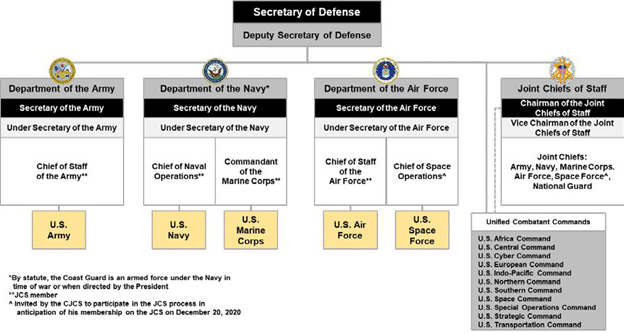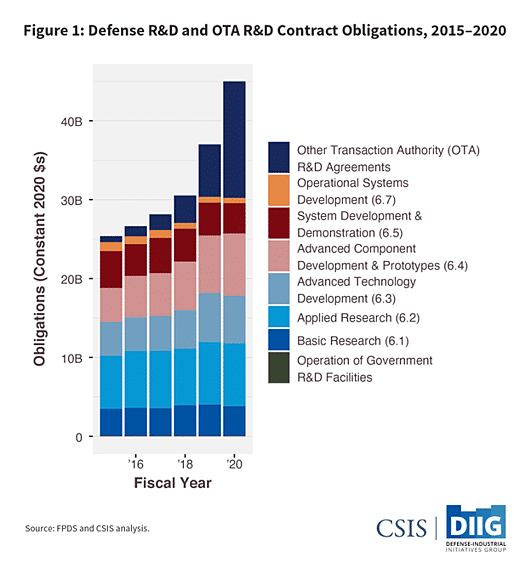About the U.S. Department of Defense (U.S. DoD)
Need-to-know facts and figures about the U.S. military to help Canadian businesses learn more about America’s largest government agency.
U.S. Department of Defense (U.S. DoD) contracts are regularly awarded to Canadian companies that take the time to learn about the U.S. military. This article will guide you on what you need to know about the agency, the size and scale of the opportunities available to Canadian-based businesses, how the public procurement process works and how you can leverage CCC to help you grow your business.
Structure
The Department of Defense (DoD) is the United States’ largest government agency and one of the largest employers in the world, with a budget of $822 billion (2022), supporting 1.3 million active duty service members and 743,000 civilian personnel spread across 4,800 sites in over 160 countries. In essence, the U.S. DoD is one of the world’s largest “company”, representing a huge opportunity for both domestic and international contractors of all types.
Leadership
The secretary of defense reports directly to the President (Commander in Chief) and heads up the military and each of its branches. Along with the Department of Homeland Security, the Department of Defense is an executive department of the United States Armed Forces.
Within the U.S. DoD, there are three military departments—the Department of the Army, the Department of the Navy, and the Department of the Air Force—each of which has their own military service branches.
There are also four national intelligence agencies that report to the U.S. DoD: the Defense Intelligence Agency (DIA), the National Security Agency (NSA), the National Geospatial-Intelligence Agency (NGA), and the National Reconnaissance Office (NRO).
The U.S. DoD organizational structure also consists of a Joint Chiefs of Staff (JCS), which is a group of senior uniformed leaders who advise the Secretary of Defense, the Homeland Security Council, the National Security Council, and the President on military matters. The JCS is composed of a Chairman, Vice Chairman, Senior Enlisted Advisor to the Chairman, and the Chief of National Guard Bureau as well as Military Service Chiefs from the Army, Marine Corps, Navy, Air Force, and Space Force.
Branches of the U.S. Military
The U.S. DoD controls five of the six branches of the military—Air Force, Army, Marine Corps, Navy and Space Force—with the Coast Guard reporting into the Department of Homeland Security. There are also reserve components—the Army National Guard and the Air National Guard—that operate in part under state authority. Here’s a brief description of the six U.S. military branches:
U.S. Army: The oldest service in the military, the Army, is the land service branch of the United States Armed Forces, providing ground forces to protect the United States and its global allies. It also protects U.S. installations and properties around the world. Additionally, each U.S. state has its own Army National Guard, which is in fact, a requirement of the U.S. Constitution (making it unique in this regard).
U.S. Marine Corps: The Marine Corps or U.S. Marines is the maritime land force service branch of the United States Armed Forces and is often the first branch deployed on the ground in combat. They are trained for both land and sea combat, with their own infantry, armour, artillery, aerial, and special operations forces.
U.S. Navy: The maritime services branch of the United States Armed Forces, the U.S. Navy, conducts missions primarily by sea but also by air and land. One of the biggest navies in the world, its core mission is to secure and protect the world’s oceans to foster safety for travel and trade.
U.S. Air Force: The United States Air Force (USAF) is the air service branch of the United States Armed Forces, operating planes, helicopters, and satellites. Its mission is to defend the United States in the air, space, and cyberspace. In addition, the Air National Guard acts as a separate reserve component of the USAF.
U.S. Space Force: The newest branch of the military and sister branch to the U.S. Air Force, the U.S. Space Force organizes, trains, and equips space forces with a view to protecting the interests of the U.S. and its allies in space.
U.S. Coast Guard: The United States Coast Guard (USCG) is the maritime security, search and rescue, and law enforcement service branch of the U.S. Armed Forces. USCG operates under the Department of Homeland Security, unlike the other five military branches. Both a humanitarian and a security service, the Coast Guard has jurisdiction in both domestic and international waters to conduct rescue operations, law enforcement, and drug prevention, as well as clear waterways.
Lastly, the U.S. DoD has 11 Unified Combatant Commands that include units from two or more service branches of the U.S. Armed Forces. These joint military commands conduct broad and continuous missions and are organized either geographically or functionally:
- Africa Command
- Central Command
- Cyber Command
- European Command
- Indo-Pacific Command
- Northern Command
- Southern Command
- Space Command
- Special Operations Command
- Strategic Command
- Transportation Command

U.S. defense budget
U.S. military spending grew $71 billion in 2022 to an estimated $887 billion USD, according to data published by the Stockholm International Peace Research Institute (SIPRI). For context, this accounted for a remarkable 39% of the almost $2.2 trillion USD in global military spending in 2022. In fact, the U.S. spent more on the military in 2022 than the next 10 top spending countries combined. Total defence spending by country, 2022, $USD:- United States: $877B
- China: $292B
- Russia: $86.4B
- India: $81.4B
- Saudi Arabia: $75.0B
- United Kingdom: $68.5B
- Germany: $55.8B
- France: $53.6B
- Japan: $46.0B
- Ukraine: $44.0B
- Italy: $33.5B
- Australia: $32.3B
- Canada: $26.9B
- Israel: $23.4B
U.S. military spending
When it comes to military spending as a percentage of GDP, no other G7 country came close to the United States, who in 2022, spent 3.5% of their approximate $25.46 trillion GDP on defence. Here is how much the other G7 countries spent on military as percentage of their gross domestic product:
- United States: 3.5%
- United Kingdom: 2.2%
- France: 1.9%
- Italy: 1.7%
- Germany: 1.4%
- Canada: 1.2%
- Japan: 1.1%
Source: Trends in World Military, 2022
U.S. DoD contract obligations
The U.S. DoD spends billions of dollars on contracts with domestic and foreign suppliers every year. There is a common misconception that the department only issues contracts to large companies in defence and closely adjacent sectors, but nothing could be further from the truth.
The annual amount spent on U.S. DoD contacts has steadily increased since 2015 and, in 2020, skyrocketed to $421.3 billion—a dramatic 41 percent increase over the previous year. This increase coincided with a surge in product spending and traditional contracts being partially displaced by a spike in Other Transaction Authority (OTA) agreements as a means of conducting research and development. Also, of note in 2020, U.S. DoD contracting obligations rose to nearly 58 percent of the total defence budget—the highest share devoted to contracts in two decades

Opportunities for non-defence companies
Having established how much the U.S. DoD is spending annually on contract obligations, it is important for would-be contractors to understand where that money is being spent and where the greatest opportunities exist.
While the top spending categories are in defence-adjacent areas such as armored vehicle, tank, and aircraft manufacturing as well as navigation and nautical systems, there are billions of dollars spent every year on a wide variety of non-military goods. According to Bloomberg Government, the 2023 U.S. DoD projected spending by category on non-traditional defence goods are as follows:
- Drugs and pharmaceutical products – $36.8 billion
- Systems development – $25.7 billion
- Facility related services – $24.5 billion
- Technical and engineering services (non-IT) – $22.9 billion
- Engines, components and other specialized equipment – $22.1 billion
- Management advisory services – $21.7 billion
- Construction related services – $19.6 billion
- Maintenance, repair and overhaul – $18.5 billion
U.S. DoD contract opportunities for Canadian firms
Just as the U.S. DoD contracts extensively with non-defence companies, so too does it award contracts to non-U.S. suppliers, including those based in Canada. Existing agreements give Canadian companies almost full access to U.S. military procurement opportunities. According to Innovation, Science and Economic Development Canada, defence export sales to the U.S. from Canada was approximately $3 billion in 2020.
Constantly looking to broaden its North American supply base, the U.S DoD is always looking for reliable Canadian companies with which to contract. Many Canadian companies may not even know that the product or service they offer is sought-after by the U.S. DoD—think shoes, vehicle part manufacturers, software publishers, office furniture manufacturers, and more.
U.S. DoD procurement offices
Because U.S. DoD procurement is complex and decentralized (for starters, there are 22 different procurement organizations), it can be daunting for companies new to the process to get started. Understanding the basics is a good first step to help ensure that your interactions with the U.S. military go as smoothly as possible.
U.S. procurement authority for the military is managed by the Department of Defense. The Defense Logistics Agency (DLA) manages the global supply chain—from raw materials to end user to disposition—for the Army, Navy, Air Force, Marine Corps, Space Force, Coast Guard, 11 combatant commands, other federal agencies, and partner and allied nations.
From there, each individual armed service executes its own defence procurement and is supported by distinct procurement offices. In turn, each of these offices has several sub organizations that handle specific types of procurement. Here are some of the key offices Canadian contractors should be aware of, including links to each U.S procurement website:
- U.S. Army procurement– The Office of the Assistant Secretary of the Army for Acquisition, Logistics and Technology
- U.S. Navy procurement– The Office of the Assistant Secretary of the Navy for Research, Development and Acquisition (including the U.S. Marine Corps)
- U.S. Air Force procurement– The Office of the Assistant Secretary of the Air Force
- U.S. Coast Guard procurement– United States Coast Guard Acquisition Directorate
Would-be contractors not directly involved in defence should also get acquainted with DLA Troop Support, the disposition service responsible for providing non-military supplies and services including food, clothing, fuel, medical supplies, construction supplies, repair parts, and more.
U.S. military procurement regulations
Broadly speaking, the Federal Acquisition Regulations (FAR) govern U.S. Government purchases. The U.S. DoD also has supplemental regulations known as the Defense Federal Acquisition Regulation Supplement (DFARS). These specific regulations are based upon U.S. DoD policy and/or U.S. law. To gain a better understanding of the DFARS, it’s a good idea to familiarize yourself with the complementary Procedures, Guidance, and Information (PGI).
DPSA, DFARS: Agreements for U.S. military to buy from Canada
Procurement advantages for Canadian firms
There are a number of factors that make Canadian businesses especially well-positioned to sell to the U.S DoD, not least of which is the Canada-U.S. Defence Production Sharing Agreement (DPSA), which gives Canadian companies almost full access to U.S. military procurement opportunities. In effect, the DPSA levels the playing field by waiving the Buy America Act and treating Canadian firms as domestic sources of supply, enabling Canadians to compete on equal footing with those based in the U.S. In addition, Canadian firms enjoy duty-free entry of their supplies and do not normally require export permits, which can quicken the process significantly. Selling to the U.S. military with CCCSelling to the U.S. DoD is a powerful way for Canadian companies of all types and sizes to elevate their business. Learn how to take advantage of this huge opportunity with CCC’s step-by-step guide.
U.S. DoD innovation programs
In addition to selling fully commercialized good and services to the U.S. military, Canadian businesses can participate in the U.S. DoD innovation ecosystem.
The U.S. military has a vast number of programs that allows the organizations within the U.S. DoD to experiment with innovations coming from entrepreneurs and non-traditional vendors. It often explores the latest advances in dual use technologies that are needed for the future fighting force such as artificial intelligence (AI), robotics, 3-D printing, augmented reality, autonomy, quantum computing, resilient networks, human systems, space, and cybersecurity.
How CCC can help you
For over 65 years, CCC has worked closely with the U.S. DoD to strengthen the North American defence industrial base and to meet the needs of the U.S. military. The first step is finding the right opportunity to bid on, and CCC offers a tool called the Global Bid Opportunity Finder (GBOF) which gives access to hundreds of thousands of tenders on a single web platform.
Once the right opportunity to bid on is found, the CCC can serve as an ally in levelling the playing field by:
- Helping to navigate the procurement process and solicitation documents
- Endorsing proposals to the U.S. DoD
- Certifying prices to the U.S. DoD as fair and reasonable
- Advocating on Canadian companies’ behalf with U.S. government officials
- Providing contract administration and oversight
If you’re ready to submit a bid or preparing a proposal, you can book a 30-minute consultation with a CCC contract manager to ensure your proposal meets the criteria.

This post was last updated on November 1, 2023.
If you’re looking to grow your exports to the United States, the U.S. Department of Defense (DoD) could be a big source of opportunity — even if your business isn’t directly involved in the defence sector.
Find out how to go about seizing US DoD defence opportunities. The first step is to get up to speed on some of the basic mechanisms of the Canada-U.S. Defense Production Sharing Agreement (DPSA).
Let us help you explore ways that the Government of Canada can help you win more international deals.

